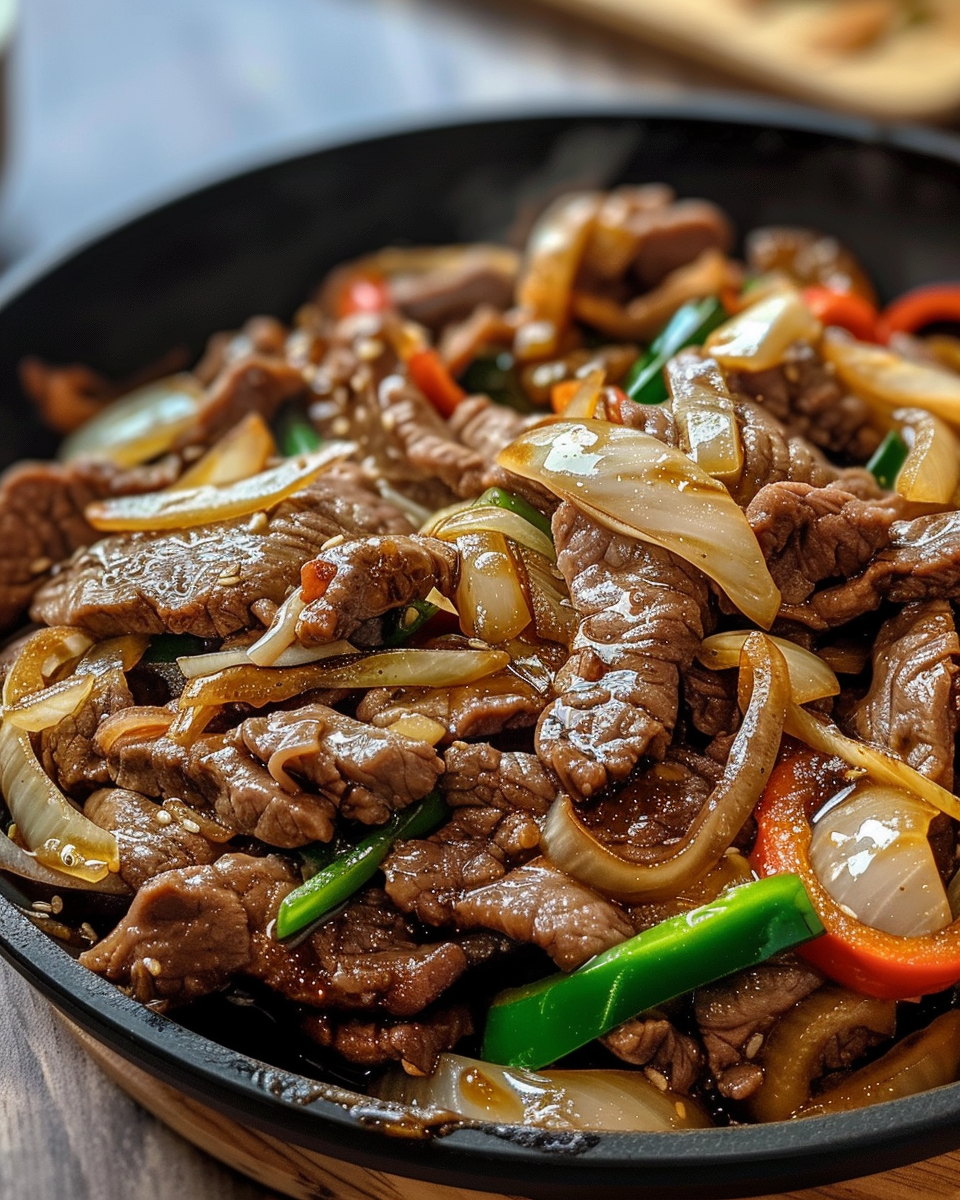Introduction
Chinese stir-fries have long been a favorite globally, thanks to their vibrant flavors, quick cooking time, and healthy ingredients. The beauty of Chinese cuisine lies in its balance—quickly cooked, nutrient-packed, and incredibly delicious. One dish that exemplifies this balance is the Chinese-style beef and onion stir-fry.
In Chinese cooking, stir-fries are more than just a method; they represent the heart of home-cooked meals. They’re fast, flavorful, and versatile, making them ideal for busy weeknights or a shared family feast. This particular dish combines the tenderness of beef with the sweet and savory depth of sautéed onions, creating a harmonious blend of textures and flavors that’s hard to resist.
Why You Should Try It
One of the greatest benefits of stir-frying is the speed and efficiency it offers. Cooking at high heat seals in the flavors while keeping the ingredients’ textures intact, preserving both nutrients and taste. The ingredients in this recipe come together in minutes, making it a go-to option for those who want something flavorful yet easy. Plus, it’s easily customizable, from varying the heat level to adding your choice of vegetables.
So, what makes Chinese-style beef and onion stir-fry stand out? It’s a balance of flavors—savory soy sauce, tender beef, crunchy onions, and aromatic garlic and ginger, all wrapped in a glossy, flavorful sauce. It’s a classic stir-fry dish that proves you don’t need a long list of ingredients or complicated techniques to create something amazing.
Ingredients
Main Ingredients
- Beef: The choice of beef is crucial for achieving the perfect texture in this dish. Cuts like flank steak, sirloin, or skirt steak are ideal for stir-frying because they’re tender, absorb marinades well, and cook quickly. Slice the beef thinly against the grain to ensure it remains tender and juicy.
- Onions: Onions, the star vegetable of this dish, add sweetness and a subtle crunch. You can use yellow, white, or even red onions, depending on your flavor preference. Yellow onions add a mild sweetness, while white onions offer a sharper bite. Red onions can provide both color and a more pungent flavor.
Marinade Ingredients
To ensure the beef is tender and full of flavor, marinate it with a few essential ingredients:
- Soy Sauce (both regular and dark): Adds depth and umami to the dish.
- Cornstarch: This helps tenderize the beef and gives it a silky texture once cooked.
- Shaoxing Wine: A traditional Chinese cooking wine that adds a subtle richness to the dish. If you don’t have it, dry sherry works well as a substitute.
- Sugar: Balances the saltiness of the soy sauce with a touch of sweetness.
- Oyster Sauce: Provides an extra layer of umami and thickens the sauce.
Aromatics and Vegetables
- Garlic and Ginger: The foundation of flavor in many Chinese stir-fries. These two ingredients create a fragrant base that permeates the entire dish.
- Optional Vegetables: You can elevate the dish by adding vegetables like bell peppers, carrots, or mushrooms for more texture and color variety.
Sauce Ingredients
- Soy Sauce, Oyster Sauce, and Broth: These form the backbone of the stir-fry sauce, providing a combination of salty, umami, and slightly sweet flavors.
- Cornstarch Slurry: A simple mix of cornstarch and water that thickens the sauce, ensuring it coats each piece of beef and onion perfectly.
- Optional Chili Paste: For those who like a bit of heat, a spoonful of chili paste or chili oil can be added to spice things up.
Instructions: Step-by-Step Guide
Preparation
- Slicing the Beef: First, slice the beef into thin strips, about 1/4-inch thick, making sure to cut against the grain. This technique helps break down the muscle fibers, ensuring the beef remains tender during cooking.
- Marinating the Beef: In a bowl, combine the soy sauce, Shaoxing wine, cornstarch, and sugar. Add the sliced beef to the mixture and let it marinate for 15-30 minutes. This not only enhances the flavor but also tenderizes the beef.
- Prepping the Onions and Vegetables: Thinly slice the onions into even rings or half-moons. If you’re adding optional vegetables, slice them into bite-sized pieces to ensure they cook evenly.
- Mixing the Sauce: In a small bowl, whisk together soy sauce, oyster sauce, broth, and cornstarch slurry, ensuring the cornstarch is fully dissolved to avoid clumps.
Stir-Frying Process
- Step 1: Heating the Wok: Heat a large wok or skillet over high heat until it’s smoking hot. The high heat is crucial for achieving the signature wok hei, or “breath of the wok,” which gives stir-fried dishes their unique flavor.
- Step 2: Cooking the Beef: Add a tablespoon of oil to the wok, and once it’s shimmering, add the marinated beef in a single layer. Sear the beef until it’s browned on the outside but still tender inside (about 2-3 minutes). Remove the beef from the wok and set aside.
- Step 3: Stir-frying the Onions: Add more oil if needed and toss in the onions. Stir-fry them for 2-3 minutes until they soften but still retain some crunch.
- Step 4: Combining Ingredients: Return the beef to the wok, and pour the sauce mixture over everything. Stir everything together, ensuring the sauce evenly coats the beef and onions. Allow the sauce to thicken and glaze the ingredients for 1-2 minutes.
- Finishing Touches: To finish, toss in some freshly sliced scallions or a drizzle of sesame oil for an aromatic touch. If you like, garnish with toasted sesame seeds or more scallions for an extra layer of flavor and texture.
Serving Suggestions
Best Ways to Serve
- The most traditional way to serve Chinese-style beef and onion stir-fry is over a bed of steamed jasmine rice. The rice soaks up the savory sauce, balancing the meal perfectly.
- For a low-carb option, serve the stir-fry over cauliflower rice or alongside zucchini noodles.
- Noodles also pair beautifully with the dish—think lo mein or rice noodles for a complete meal.
Customizing the Dish
- Spicy Variation: If you prefer a bit of heat, add dried chili peppers or chili oil to the dish during the stir-frying process.
- Gluten-Free: Substitute regular soy sauce with tamari or coconut aminos to make the dish gluten-free without compromising the flavor.
Family-Style Serving
- Serve this dish family-style in the middle of the table alongside a few other stir-fried vegetable dishes, like bok choy or spinach, to enjoy a communal meal in traditional Chinese fashion.
Beverage Pairing
- Tea Pairings: Light teas like jasmine tea or oolong tea are great companions, as their delicate flavors don’t overpower the stir-fry.
- Non-Alcoholic: Opt for sparkling water with lime or a refreshing glass of iced green tea to balance the richness of the dish.
- Alcoholic: A crisp, light lager or a citrusy white wine can complement the dish’s savory and umami notes.
Conclusion
This Chinese-style beef and onion stir-fry is the perfect blend of simplicity, speed, and flavor. With just a few basic ingredients, you can create a dish that’s as satisfying as it is versatile. Whether you choose to keep it simple or customize it with added vegetables or spice, this dish offers endless possibilities. Plus, it’s a great recipe for experimenting with different protein options like chicken or even tofu for a vegetarian twist.
Fresh ingredients, high heat, and the right technique can turn a quick weeknight meal into something memorable and delicious. So, fire up your wok and enjoy the flavors of a classic Chinese stir-fry right at home!
FAQs
- What kind of beef is best for stir-fry?
The best cuts for stir-frying are flank steak, sirloin, or skirt steak, as they are tender and cook quickly. Be sure to slice against the grain for optimal tenderness. - Can I use frozen beef?
Yes, you can use frozen beef, but it’s best to thaw it completely before slicing. Semi-frozen beef is easier to cut thinly. - How do I prevent the beef from becoming tough?
Quick cooking at high heat, combined with marinating in soy sauce and cornstarch, helps prevent the beef from becoming tough. - Can I make this recipe gluten-free?
Absolutely! Substitute regular soy sauce with tamari or coconut aminos to make the dish gluten-free. - What can I use instead of Shaoxing wine?
If you don’t have Shaoxing wine, you can substitute it with dry sherry or rice vinegar

